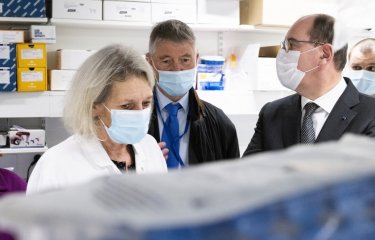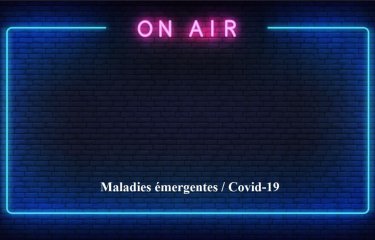Sarah Bonnet is a "tickologist" – she specializes in the study of ticks. More broadly, she is a veterinarian entomologist and medical, a professor and scientist with a passion for field work. Her research is focused on the little-known field of ticks and their many species. She is an enthusiastic educator who loves sharing her expertise and plans for future research. The upheavals we are currently witnessing as a result of climate, environmental and social factors indicate that there will be a growing need for research into ticks, vectors of multiple pathogens.
Back "home"
After completing her PhD and a postdoctoral fellowship at the Institut Pasteur, Sarah Bonnet worked for nearly 20 years at INRAE, the French National Research Institute for Agriculture, Food and the Environment. But now she's back on the Paris campus. As part of an international partnership between the Institut Pasteur and INRAE, she is pursuing her research on the hematophagous (blood-sucking) parasites.
Sarah's first scientific encounters were inspiring and influential for her future career. During her Master's and PhD in François Rodhain's unit at the Institut Pasteur she met a number of entomologists who specialized in vector ecology. Sarah recognizes their legacy on her work today.

Caption: In 1997, during her thesis, malaria prospecting in Nkolbeck (100 km east of Yaoundé), Sarah Bonnet (epidemiologist researcher), Orstom.© IRD - Jean-Yves Meunier

My mentors went on field trips, recorded data and collected samples. Back in the lab, they worked with this material. They took a holistic approach to research questions.
Ticks – not just Lyme disease
There are around 900 recorded species of ticks worldwide and more than 40 in France alone. On the whole, the public is relatively unfamiliar with these blood-sucking ectoparasites (external parasites). Although most ticks are harmless for humans, several species, primarily those in the Ixodes and Dermacentor genera in France, can transmit zoonotic pathogens. Sarah's expertise covers the ticks found in France and also those in other world regions.
"Mosquitoes, vectors of multiple pathogens in the southern hemisphere, are the focus of a great deal of research. But ticks, despite being the leading vector of pathogens for animals and humans in the northern hemisphere, are relatively under-researched – there is a lot of work still to do!"
Because mosquitoes can fly, they breed and multiply in places where humans live. But with ticks it is the other way round – they are mainly found in nature, and humans enter their biotope.
Humans are an accidental host. In their natural habitat, ticks feed and reproduce by parasitizing domestic or wild animals and livestock. But changing climate, environmental and socio-economic conditions are prompting scientists to take a closer interest in ticks. In light of this development, to meet growing demand Sarah has launched a university program (DU-UPEC) on "The impact of tick-related zoonoses for humans and animals – a One Health approach," which she coordinates with colleagues from Henri Mondor and Intercommunal de Villeneuve-Saint-Georges hospitals and the École vétérinaire d'Alfort.
Anticipating risks induced by global changes
Climate change and global warming are disrupting ecosystems. The tick species that live in France appreciate a damp climate, but other species such as Hyalomma marginatum, which prefer long hot summers, have been recorded in regions where they are not usually found. This species, recently detected in the south of France, belongs to a genus endemic to Africa, the Balkans, the Middle East and Asia which can transmit Crimean-Congo hemorrhagic fever (CCHF), a zoonotic disease with a case fatality rate of 10 to 40%. There is currently no vaccine for CCHF. Cases have been reported in Spain every year since 2016, and there have been recurrent outbreaks in Turkey for many years.

With summer temperatures nearing 40°C in cities, there is a tendency to create increasing numbers of green spaces in towns and cities, with green corridors linking rural and urban areas. This has many advantages, but there needs to be an awareness of all the implications. For example, in towns and cities, we shouldn't be creating areas that can serve as breeding grounds for mosquitoes or providing access for tick-bearing wild mammals
A project supported by the LabEx IBEID is under way to map risks associated with ticks along an urbanization gradient in the Greater Paris region. As a partner of the European
"He-farm" project, Sarah is also investigating the issue from the angle of livestock breeding practices.

Establishing international surveillance networks
«The INRAE-Institut Pasteur partnership synergizes the strengths and skills needed to investigate the health risks related to ticks, at international level and in a One Health approach.»
This synergistic strategy has given rise to a unique research collective on the topic of emerging tick-borne diseases. It combines research and development with disease control via a One Health approach. With Sébastien Boyer from the Institut Pasteur du Cambodge, Sarah runs training in Cambodia to develop veterinary entomology in the country. With Anna-Bella Failloux from the Institut Pasteur in Paris and Youmna M'ghirbi from the Institut Pasteur de Tunis, she is helping to establish a network within the Pasteur Network to foster links between laboratories that already work on ticks and tick-related diseases or are interested in doing so.
A new building for vector research with breeding facilities for ticks will also soon be opening on the Institut Pasteur campus. Sarah will offer her expertise in the field, and the breeding facilities will provide important biological material for future projects.
Finding a reliable biomarker to monitor tick-related diseases
Field collections alone do not provide enough information to "map" the exposure of individuals to ticks and the pathogens they carry. Sarah believes that the solution is to identify reliable markers to evaluate these risks.
"By means of a simple blood test on people or animals that have been exposed to ticks, we can check for specific antibodies to confirm whether or not there is a history of tick bite and, we hope, identify the species responsible."
An initial study aimed at identifying markers is under way as part of the PICREID project (Pasteur International Center for Research on Emerging Infectious Diseases) coordinated by Anavaj Sakuntabhai, in collaboration with the Institut Pasteur du Cambodge. A study is also planned in connection with our international unit with Kyoto University in Japan, at two sites in the country, one near Kyoto and another on the island of Hokkaido.

Caption: Veterinary entomology course at the Pasteur Institute in Phnom Penh, Cambodia
Key dates in Sarah Bonnet's career
Since 2022: Group leader in the Ecology and Emergence of Arthropod-borne Pathogens Unit (USC Institut Pasteur-INRAE) led by Anavaj Sakuntabhai
2015: Winner of the 2015 Alfred Kastler Biology Prize awarded by the Fondation Droit Animal, Ethique et Sciences (LFDA)
Since 2004: Research associate then research director at INRAE, UMR IHPM, INRAE-Ecole vétérinaire de Nantes (2004-2007), UMR BIPAR, INRAE-ANSES-Ecole vétérinaire d'Alfort (2007-2021) – Research into interactions between ticks, pathogens and hosts: epidemiology, establishing tick breeding facilities, experimental infection, tick saliva analysis, vaccine trials against ticks in animal models, etc.
2000: PhD on host-parasite interactions, Pierre & Marie Curie University, Paris VI: "Transmission of Plasmodium falciparum from humans to mosquitoes: measurement tools and potential blocking mechanisms" (Institut Pasteur and IRD Cameroon)
1996: Diploma in Medical Entomology from the Institut Pasteur in Paris
Since 2019: Chair of COMETHEA, the Committee for Ethics in Animal Experimentation at INRAE Jouy-en-Josas and AgroParisTech, and appointed member of CNREEA (French national committee for ethical reflection on animal testing)
Since 2018: Member of the "Vector" working group at ANSES, member of the Scientific Board at the Reference Center for Tick-Borne Diseases for Greater Paris and Hauts-de-France






